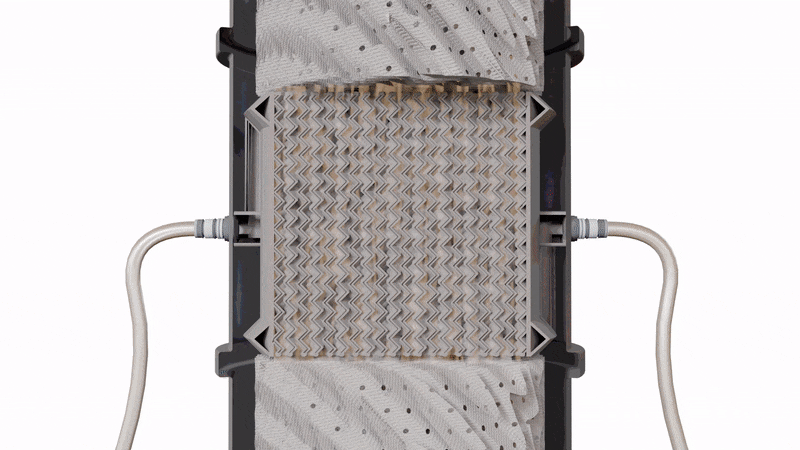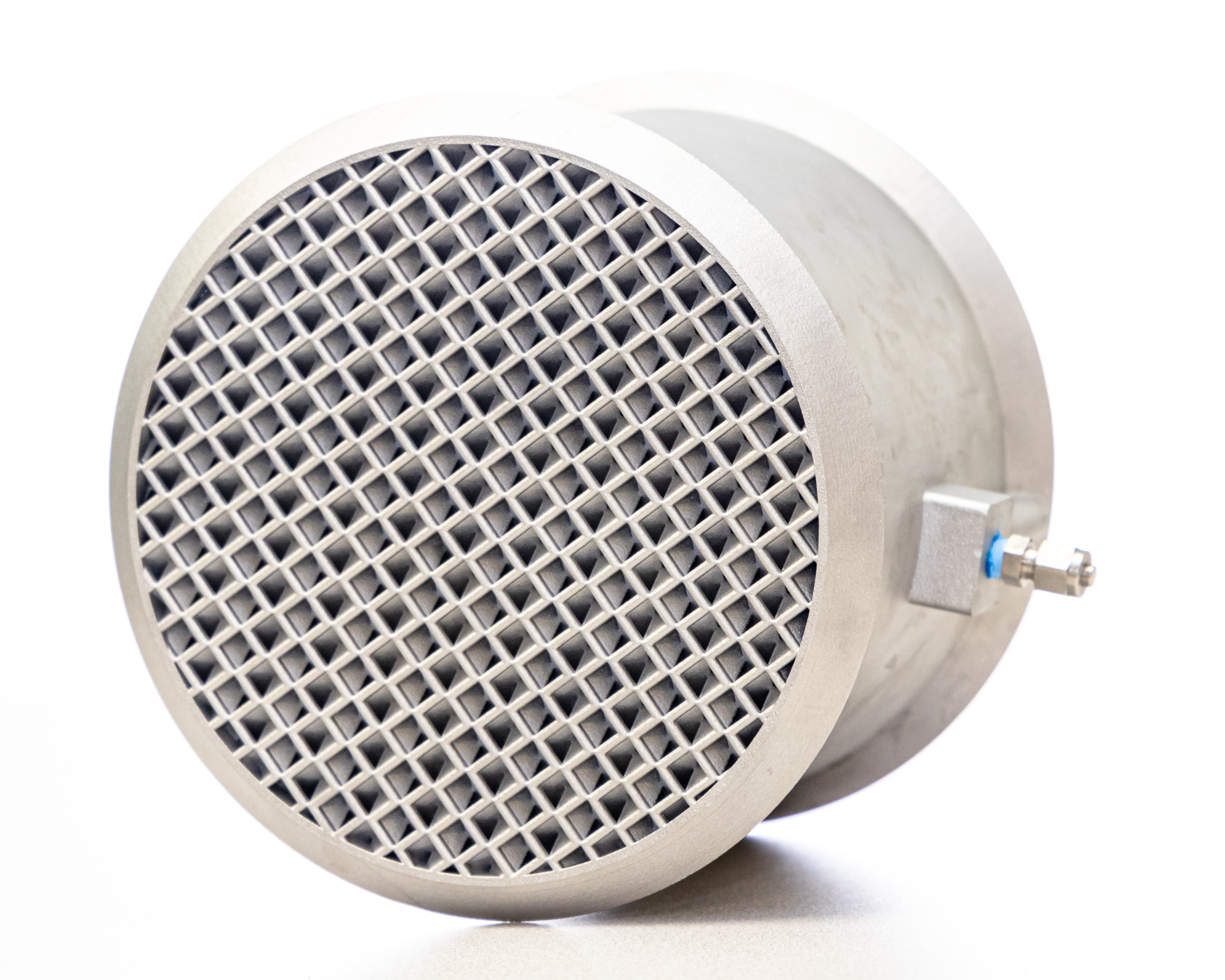Scientists from Oak Ridge National Laboratory (ORNL) have developed a novel 3D printed device that’s capable of increasing the amount of CO2 captured from burning fossil fuels.
Utilizing 3D printing, the researchers were able to combine a heat exchanger and a mass-exchanging contactor, into a multifunctional CO2 absorption device. The aluminum contraption’s in-situ cooling capabilities allows more carbon dioxide to be transferred from a gas into a liquid state, enhancing its rate of carbon retention. Summary testing showed that up to 20 percent of CO2 generated by industrial processes could be absorbed via the implementation of the ORNL team’s new component.
“Prior to the design of our 3D printed device, it was difficult to implement a heat exchanger concept into the CO2 absorption column because of the complex geometry of the column’s packing elements,” said Xin Sun, Principal Investigator on the project. “With 3D printing, the mass exchanger and heat exchanger can co-exist within a single multifunctional, intensified device,”
“Controlling the temperature of absorption is critical to capturing carbon dioxide.”

Absorption and reducing CO2 emissions
Carbon Capture and Storage (CCS) is an important method of limiting CO2 emissions within a number of industrial processes and a key weapon in the fight against climate change. Absorption, in turn, is both the cheapest available CCS method and the most explored, with studies on carbon absorption dating back to the 1960s.
In order to implement an absorption strategy, a flue-gas stream containing carbon dioxide needs to be placed in direct contact with a solvent that has a chemical affinity to CO2. Monoethanolamine (MEA), a commonly-used solvent, is capable of bonding with carbon dioxide molecules, and its reaction makes its replacement by another MEA molecule fast and favorable. As a result, MEA’s absorbency makes it ideal for capturing toxic emissions.
Given that CCS requires CO2 to diffuse into a bulk liquid phase, it is also desirable to maximize the contact area between the gas stream and liquid solvent. Expanding a solvent’s surface area can either be achieved by channeled, structured packing, or the random packing of shapes such as small rings. Structured solvents are optimal for CCS, as they guide fluids through well-defined and repeated flow paths, optimizing absorbency.
Although MEA scrubbing is a well-documented approach, it has not been widely adopted due to its temperature-dependent tendency to degrade. At high temperatures, the solubility of CO2 diminishes, which reduces its absorbency, and limits the amount of rich solvent loading. At temperatures above 80 °C, 60 to 80 percent of the carbon dioxide is desorbed, significantly hindering the capacity of MEA to prevent carbon emissions.
Interstage cooling has been touted as a solution to MEA’s overheating problem. Previous research has shown that drawing off the solvent and passing it through a heat exchanger reduces the amount of CO2 lost to changes in temperature. The drawback of this ex-situ approach is that its increased complexity often leads to higher implementation costs.

The ORNL 3D printed cooling strategy
Using 3D printing, the ORNL team created a device that combined two separate functions into a single stage, managing both the contact phase and heat exchange. Instead of producing assemblies with complicated coolant designs, additive manufacturing enabled the researchers to incorporate channels into the packed device without disturbing its geometry.
The ORNL team 3D printed their prototype using aluminum and designed the device to include embedded coolant channels in between the corrugated sheets of its structured packing. The final multifunctional device measured 20.3 cm in diameter, 14.6 cm in height, and featured a total volume of internal coolant channels of 600 mL.
“The device can be manufactured using other materials, such as emerging high thermal conductivity polymers and metals,” added Lonnie Love, the ORNL researcher that designed the component. “Additive manufacturing methods like 3D printing are often cost-effective over time because it takes less effort and energy to print a part versus traditional manufacturing methods.”

In order to test their prototype, the ORNL team fitted it to an absorption column measuring 2.06 m in height and 20.3 cm in diameter. Given that it took a considerable amount of time for heat to accumulate near their device, the researchers heated the solvent to 70oC, before pumping them into the column from the bottom up.
Mass transfer measurements obtained using a CO2 meter showed that the team’s 3D printed device was more absorbent than commercially available ex-situ cooled alternatives. At its peak, 20 percent of the total carbon dioxide concentration, corresponding to 360 SLPM of air and 90 SLPM of CO2 was captured by their additive absorbent.
Further testing revealed that an increased airflow rate acted to reduce the mass transfer of CO2 into the team’s contraption. In turn, decreasing the airflow rate to 264 SLPM before cooling was found to improve the capture rate, with up to 94 percent of the carbon absorbed. In contrast, the device’s thermal performance was unable to match that of commercial heat exchangers, and it couldn’t be cooled below 40oC, its optimal operating temperature.
Still, regardless of the device’s thermal shortcomings, the ORNL researchers concluded that further optimizing the device’s geometry could yet yield greater improvements in the amount of CO2 it absorbs. “The success of this 3D printed intensified device represents an unprecedented opportunity in further enhancing carbon dioxide absorption efficiency and demonstrates proof of concept,” concluded Sun.
Eco-friendly innovations in 3D printing
Researchers have used 3D printing to reduce the impact of mass manufacturing on the environment within a wide range of applications in recent years.
Scientists from the Catalonia Institute for Energy Research and Catalan Institution for Research and Advanced Studies have 3D printed enhanced Solid Oxide Fuel Cells (SOFCs). The “new generation” of energy cells could be used in end-use electricity generation applications, or to create enhanced energy storage devices.
An international materials research project has developed a 3D printable metal alloy that can make refrigeration cooling systems more energy efficient. The material, a combination of nickel and titanium, is a type of shape memory alloy that can repeatedly transform to pump heat out of a system.
Similarly, researchers from the Universiti Teknologi Malaysia, have proposed 3D printing as an alternative method of making the plates that power thermoacoustic refrigerators (TARs). Leveraging a Stratasys system, the team managed to increase the thickness of the plates by 40 percent.
The researchers’ findings are detailed in their paper titled “Process intensification of CO2 absorption using a 3D printed intensified packing device,” which was published in the AIChE journal. The report was co-authored by Eduardo Miramontes, Ella A. Jiang, Lonnie J. Love, Canhai Lai, Xin Sun, and Costas Tsouris.
Nominations for the 2020 3D Printing Industry Awards are still open, let us know who is leading the industry now.
The fourth edition of the 3D Printing Industry Awards Trophy Design Competition is now underway. Enter your design for the chance to win a CraftBot Flow 3D printer.
To stay up to date with the latest 3D printing news, don’t forget to subscribe to the 3D Printing Industry newsletter or follow us on Twitter or liking our page on Facebook.
Are you looking for a job in the additive manufacturing industry? Visit 3D Printing Jobs for a selection of roles in the industry.
Featured image shows a GIF of the ORNL team’s 3D printed carbon-capturing device. GIF via Michelle Lehman, ORNL.



